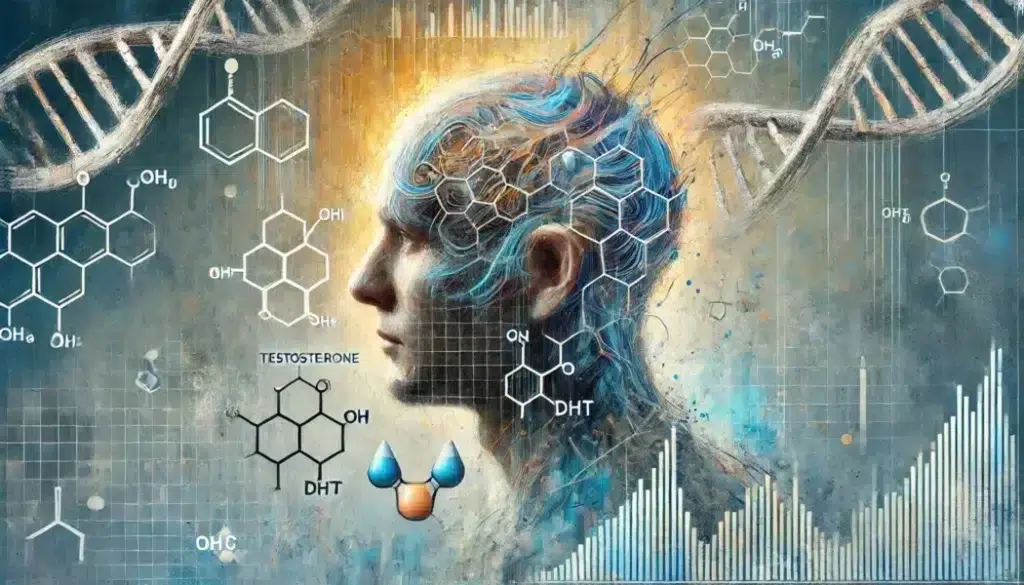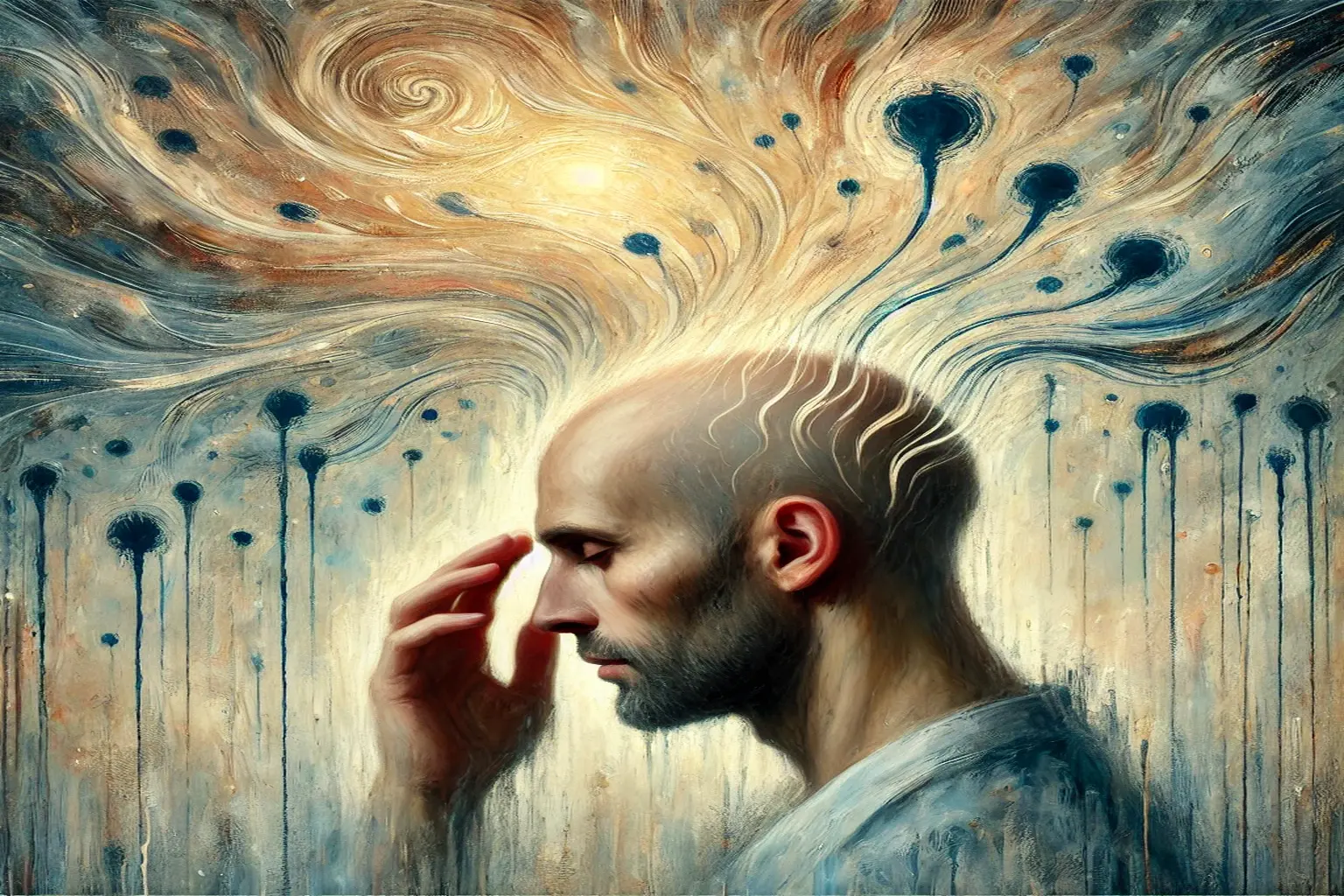Alopecia Androgenetica, commonly known as male pattern baldness, isn’t just a men’s grooming challenge; it’s a widespread condition impacting millions across the globe. This hair loss type is all about genetics and hormones deciding to team up against your locks, making it a common cause of hair thinning in men.
When we talk about genetics, we’re basically dealing with what happens when your genes passed down from your parents give you a deal you didn’t sign up for—hair thinning starting at the hairline and crown. The genetic link is super strong here, and if your dad or grandpa started losing their hair early, chances are you might too.

To understand when this party—or hair thinning—typically starts, many guys notice this as early as their late teens to early twenties. Yeah, it can happen that soon, though it’s more common in your late twenties and thirties. It doesn’t stop there—it progresses at its own pace, with hair slowly becoming finer and shorter over time.
Hormonally speaking, Dihydrotestosterone (or DHT for short) is the guy you didn’t invite to the party but who showed up anyway. It’s a derivative of testosterone and makes hair follicles shrink, resulting in the notorious hair loss pattern so many recognize. This ‘shrinkage’ means hair grows back thinner until it stops growing altogether in certain areas.
Grasping the early signs, such as a receding hairline or thinning around the crown area, is key. Recognizing these early can help you stay ahead—whether you’re looking at hair care routines or a bit of friendly chat with a dermatologist.
💭 Psychological Impact: How Mental Well-being Can Influence Hair Loss
Hair loss is not just a physical thing—it digs deep into our emotions and mental health too. Many men experience stress and anxiety linked with the gradual disappearance of their hair. You might start feeling self-conscious seeing more scalp in the mirror, and it’s not unusual for this to impact your mood and even your general mental health.
Stress is a sneaky contributor to hair loss. It can accelerate the process, making hair thinning more pronounced. This stress-hair loss cycle is tricky, kind of like a never-ending merry-go-round. When you notice your confidence taking a hit or anxiety levels spiking due to how your hair looks, it’s time to pause and take note.

Societal pressures don’t make it any easier. The media often paints a picture of the ‘ideal’ image of masculinity, which can leave you feeling like you’re not measuring up if you’re lacking in the hair department. Addressing this pressure internally often becomes just as crucial as dealing with the hair loss itself.
Opening up about how you’re feeling—whether with friends, family, or a mental health professional—can provide relief and a new perspective. Sometimes just acknowledging the struggle is half the battle won. Consider swapping stories with others going through the same thing, or reading personal testimonials. They can offer solidarity and insight that you’re definitely not alone in this journey.
🚀 The Future of Hair Loss Treatment: Innovative Solutions on the Horizon
Science is on your side when it comes to tackling alopecia androgenetica. With ongoing research and advancements in hair restoration, the future looks promising for managing hair loss more effectively. Researchers are diving into new therapies that aim to not just slow down the hair loss process but potentially even reverse it.
For men affected by androgenetic alopecia, there are currently several highly effective solutions available to counteract the destructive effects of DHT on hair follicles and promote new hair growth. These methods include:
Laser Therapy is an innovative and highly effective treatment option. It uses low-level laser technology to strongly stimulate hair follicles, promoting new growth. This method is safe, non-invasive, easy to use, and widely accessible for treating hair issues
Lotions made with natural DHT blockers and minoxidil. These formulations are clinically proven to stimulate the growth of new hair by improving follicle health.
Shampoos containing natural DHT blockers and minoxidil. Regular use not only helps reduce hair loss but also enhances the potential for regrowth by nourishing the scalp.
Supplements formulated to block DHT while providing essential nutrients and active ingredients that support the natural growth cycle of hair and improve its overall quality.

Preventative measures are also part of the conversation. Dermatologists and scientists are all about finding easy, accessible means to keep hair healthier for longer. Innovations in topical treatments and supplements tailored to counteract the effects of DHT show lots of promise.
It is crucial to understand that we will almost never lose our hair due to genetic predisposition alone. In order for this to happen, additional triggers are needed, such as stress, improper diet, living in a polluted environment, and others that we described in previous posts.
So if we have managed to eliminate the “triggers” we can start using supplements that can be very effective in our efforts to restore the lushness and beauty of our hair.
Stay with us — the best is yet to come.
By following our advice, you’re doing the most you can for your hair.
Be the first to know when we publish new guides, tests, and proven strategies for stronger, healthier hair.
👉 Visit the About Me page to learn more about my journey, mission, and why helping people with hair health is so personal to me.
Want healthier, stronger hair? Discover 8 science-backed habits that protect your scalp and boost natural growth. Get your free PDF guide today!
Disclaimer: This article is for informational purposes only and is not a substitute for professional medical advice. Sensitive claims are supported with scientific references, and full product details can always be found on the official websites of the respective manufacturers or distributors.
Some links in this article are affiliate links. If you choose to make a purchase through them, I may earn a small commission at no extra cost to you — helping me keep HairGrowGenius running. Thank you for your support!

🧠 FAQ – Key Questions About Androgenetic Alopecia in Men
🧬 Is androgenetic alopecia caused only by genetics?
Not entirely. While genetic predisposition plays a big role, it’s not the whole story. Hormonal imbalances, stress, diet, and even environmental factors can influence how fast or how early it shows up. Think of it as a loaded gun — your genes pull the trigger, but your habits aim the barrel.
🧴 Can shampoos or topical treatments really slow down androgenetic alopecia?
They can help — but only if they contain the right ingredients. Look for shampoos with caffeine, rosemary, biotin, and niacinamide, which may support hair health and stimulate blood flow. Treatments with minoxidil are FDA-approved and scientifically backed to slow down the process and support regrowth
⌛ How soon should I start treating androgenetic alopecia?
The earlier, the better. Waiting until hair loss becomes obvious often makes it harder to reverse. If you’re noticing thinning or a receding hairline, now is the time to act. Early intervention increases the chance of keeping what you’ve got — and possibly regaining some of what you’ve lost.
🧾 Last updated: June 2025 based on latest research.


Leave a Reply